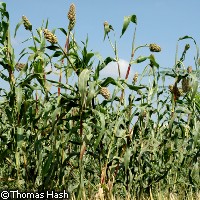Grass genome offers clues to drought tolerance
An international team of researchers has described the genome of sorghum, a drought-tolerant grass related to sugar cane and maize. The new findings, published in the journal Nature, shed light on a valuable source of food, feed and biofuel and have important implications for agriculture in arid regions with expanding populations, such as west Africa. Some 60 million tonnes of sorghum are produced annually worldwide, mainly in northeast Africa and dry areas of the US and India, as a staple food for humans and livestock. It is also grown as a source of biofuel, most notably in China. Grain sorghum has more protein and less fat than maize, while sharing similar nutritional content. Sweet sorghum is similar to sugar cane but its resistance to heat and water stress makes it more desirable as a biofuel crop. Sorghum uses a photosynthetic route called 'C4' that makes it particularly suited to assimilate more carbon at high temperatures than plants that use the usual 'C3' pathway, such as rice and wheat. It is possible that the newly described sorghum genome could pave the way for future studies to re-engineer other species, especially the rice plant, to switch from the C3 route to C4 photosynthesis, boosting yields and taking up more carbon dioxide than is currently possible. According to the study, sorghum's small genome makes it an attractive model for studying C4 grasses. The investigators succeeded in establishing an accurate and contiguous picture of the entire sorghum genome. Most notably, they identified gene duplications that are not present in other cereals that may contribute to sorghum's ability to withstand drought. The newly sequenced sorghum genome has inspired comparison studies with the rice genome, which was sequenced four years ago. Such studies of the genetic underpinning of valuable agricultural traits will, it is hoped, enable scientists to develop breeding programmes that enhance crop yields. 'We now will have a better idea of how many properties of the grasses, such as drought resistance, sugar in the stem, or grain productivity are encrypted in their genes,' said Dr Joachim Messing of Rutgers University in the US, one of the authors of the paper. 'Knowing this may enable us to laterally move these genes around among these crop species, to customise them based on the needs of geographic location and climate.' The scientists used a modified 'shotgun sequencing' method to analyse sorghum's genome. This method takes into account the highly repetitive nature of large genomes, explained Dr Messing, who developed the method: 'The efficiency and utility of this method will make it faster and far less expensive to sequence other complex genomes in the future.' In an accompanying commentary, Dr Takuji Sasaki and Dr Baltazar Antonio of the National Institute of Agrobiological Sciences in Japan point out that 'the true worth of plant genome information lies in translating those data into an improvement of crops through various breeding strategies'. They go on to explain how knowledge of sorghum's genetic sequence can be applied to other C4 grass species such as sugar cane and Miscanthus that have been targeted as potential resources for bioethanol production. 'The information to be mined from a plant genome sequence is, of course, not in itself enough to enhance such traits as photosynthetic efficiency or stress tolerance,' Drs Sasaki and Antonio write. 'But that information constitutes the most powerful tool we have for revealing ways to increase the amounts of food and energy provided by plants, and so to meet the demands of a world faced by an ever-increasing population and by an erratic climate.'
Countries
Switzerland, China, Germany, India, Pakistan, United States



